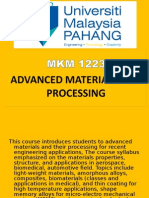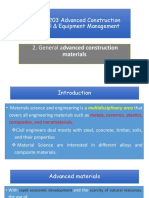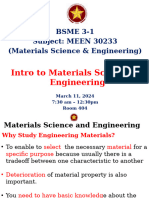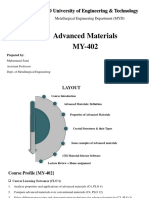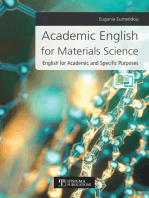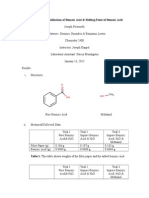0 ratings0% found this document useful (0 votes)
9 viewsChapter 1-2024
Uploaded by
hassanpurnayaCopyright
© © All Rights Reserved
Available Formats
Download as PDF, TXT or read online on Scribd
0 ratings0% found this document useful (0 votes)
9 viewsChapter 1-2024
Uploaded by
hassanpurnayaCopyright
© © All Rights Reserved
Available Formats
Download as PDF, TXT or read online on Scribd
You are on page 1/ 21
Chapter 1
Introduction to Materials Science and
Engineering
1.1 MATERIALS AND ENGINEERING
• What are Materials?
– Materials may be defined as substance of which
something is composed or made.
Foundations of Materials Science YANG Yuansheng
1.1 MATERIALS AND ENGINEERING
• The advancement of civilization has historically
depended on the improvement of materials to work
with.
– Prehistoric humans were restricted to naturally
accessible materials.
– Over time, they moved from the materials Stone Age into
the newer Copper (Bronze) and Iron ages.
– Even today we are restricted to the materials we can
obtain from earth’s crust and atmosphere
Stone Age Bronze Age Iron Age
2.5 million BC 3500 BC 1000 BC
Foundations of Materials Science YANG Yuansheng
The most common elements in earth’s crust and
atmosphere
Examples :
➢ Silicon and Iron
constitute 27.72 and
5.00 percentage of
weight of earths crust
respectively.
➢ Nitrogen and
Oxygen constitute
78.08 and 20.95
percentage of dry air
by volume
respectively.
Foundations of Materials Science YANG Yuansheng
Why the Study of Materials is Important?
• Production and processing of materials constitute a
large part of our economy.
• Engineers choose materials to suite design.
• New materials might be needed for some new
applications.
➢ Example : High temperature resistant materials.
➢ Space station should sustain conditions in space.
* High speed, low temperature, strong but light.
• Modification of properties might be needed for
some applications.
➢ Example : Heat treatment to modify properties.
Foundations of Materials Science YANG Yuansheng
1-4
Each industry seeks different characteristics in their
materials
• The search for new advanced materials goes on continuously.
• The industries require a tremendous number of materials expert.
Foundations of Materials Science YANG Yuansheng
1.2 Materials Science and Engineering
• Materials science deals with basic knowledge about the
internal structure, properties and processing of materials.
• Materials engineering deals with the application of
knowledge gained by materials science to convert
materials to products.
• Materials science & engineering: Resultant of MS & ME.
Materials Science and
Materials Science Engineering
Materials Engineering
Resultant Knowledge
Basic Knowledge of Structure, Properties, Applied
of Processing, and Knowledge
Materials Performance of of Materials
Engineering materials
Foundations of Materials Science YANG Yuansheng
1-5
Materials science and engineering forms a bridge of knowledge
from the basic sciences to the engineering disciplines.
• The three-ringed diagram indicates the relationship among the basic
sciences (and mathematics), materials science and engineering, and the
other engineering disciplines.
• Inner ring (core): basic sciences
• Middle ring: applied sciences
(metallurgy, ceramics, polymer
science. etc.)
• Outermost ring: engineering
disciplines (mechanical, electrical,
civil, chemical, etc.)
• MSE is a bridge of materials
knowledge from the basic sciences
to the engineering disciplines.
Foundations of Materials Science YANG Yuansheng
1.3 TYPES OF MATERIALS
• Based primarily on chemical makeup and atomic structure,
most engineering materials are divided into three main or
fundamental classes:
– metallic materials,
– polymeric materials,
– and ceramic materials.
• There are the composites
which are engineered
combinations of two or more
different materials.
Foundations of Materials Science YANG Yuansheng
1.3.1 Metallic Materials
• Composed of one or more metallic elements.
❑ Example:- Iron, Copper, Aluminum.
➢ Metallic element may combine with
nonmetallic elements.
❑ Example:- Silicon Carbide, Iron Oxide.
• Inorganic, crystalline structure.
• good thermal and electrical
conductors
• relatively strong and ductile at
room temperature
• good strength even at high
temperatures
The aircraft turbine engine
Foundations of Materials Science YANG Yuansheng
Classes of Metallic Materials
• Metals and alloys are commonly divided into two classes:
– ferrous metals and alloys that contain a large percentage of iron
such as the steels and cast irons and
– nonferrous metals and alloys that do not contain iron or contain
only a relatively small amount of iron.
Foundations of Materials Science YANG Yuansheng
1.3.2 Polymeric Materials
➢ Organic giant molecules and mostly noncrystalline.
➢ Some are mixtures of crystalline and noncrystalline regions.
➢ Poor conductors of electricity and hence used as insulators.
➢ Strength and ductility vary greatly.
➢ Low densities and decomposition temperatures.
➢ Examples :
➢ Plastic resin producers are developing ultrapure, high-flow grades of
polycarbonate plastic for DVDs.
➢ Synthetic rubber is often used in the structure of tires because of its
strength, durability, and thermal stability.
Foundations of Materials Science YANG Yuansheng
Ceramic Materials
➢ Metallic and nonmetallic elements are chemically bonded together.
➢ Inorganic but can be either crystalline, noncrystalline or mixture of both.
➢ High hardness, strength and wear resistance.
➢ Very good insulator. Hence used for furnace lining for heat treating and
melting metals.
➢ Also used in space shuttle to insulate it during exit and reentry into
atmosphere.
Examples of a newly developed
generation of engineered ceramic
materials for advanced engine
applications.
• The black items include engine valves,
valve seat inserts, and piston pins made
of silicon nitride.
• The white item is a port-manifold liner
made of an alumina ceramic material.
Foundations of Materials Science YANG Yuansheng
Composite Materials
➢Mixture of two or more materials.
➢ Consists of a filler material and a binding material.
➢ Materials only bond, will not dissolve in each other.
➢ Mainly two types :-
o Fibrous: Fibers in a matrix
o Particulate: Particles in a matrix
o Matrix can be metals, ceramic or polymer
➢ Examples :
❑ Fiber Glass ( Reinforcing material in a polyester
or epoxy matrix)
❑ Concrete ( Gravels or steel rods reinforced in
cement and sand)
➢ Applications: Aircraft wings and engine, construction.
Foundations of Materials Science YANG Yuansheng
1.4 ADVANCED MATERIALS
• Materials that are utilized in high-technology applications
are sometimes termed advanced materials.
• These advanced materials are typically traditional materials
whose properties have been enhanced, and also newly
developed, high-performance materials.
• they may be of all material types (e.g., metals, ceramics,
polymers), and are normally expensive.
– electric materials
– Biomaterials
– smart materials
– nano-materials, etc.
Foundations of Materials Science YANG Yuansheng
• Electronic materials
– Electronic materials are an extremely important type of
material for advanced engineering technology.
– The applications of electronic materials in the
semiconductor industry.
– The most important electronic material is pure silicon that
is modified in various ways to change its electrical
characteristics.
Foundations of Materials Science YANG Yuansheng
• Biomaterials
– Biomaterials are employed in components implanted into the human
body to re-place diseased or damaged body parts. These materials
must not produce toxic sub-stances and must be compatible with body
tissues.
– All of the preceding materials—metals, ceramics, polymers,
composites, and semiconductors—may be used as biomaterials.
Foundations of Materials Science YANG Yuansheng
• Smart materials
– They have the ability to sense external environmental stimuli
(temperature, stress, light, humidity, and electric and magnetic
fields) and respond to them by changing their properties
(mechanical, electrical, or appearance), structure, or functions.
These materials are generically called smart materials.
• Example: shape-memory alloys; piezoelectric ceramics.
Shape-memory alloys used as a stent to expand narrowed arteries or support weakened
ones: (a)stent on a probe and (b) stent positioned in a damaged artery for support.
Foundations of Materials Science YANG Yuansheng
• Nanomaterials
– Nanomaterials are generally defined as those materials that have a
characteristic length scale (that is, particle diameter, grain size, layer
thickness, etc.) smaller than 100 nm (1 nm = 10−9 m).
– Nanomaterials can be metallic, polymeric, ceramic, electronic, or
composite.
– Nanomaterials or nanostructured materials:
• ceramic powder aggregates of less than 100 nm in size,
• bulk metals with grain size less than 100 nm,
• thin polymeric films with thickness less than 100 nm, and
• electronic wires with diameter less than 100 nm
Foundations of Materials Science YANG Yuansheng
1.5 ENVIRONMENTAL CONSIDERATIONS
• life cycle analysis:
– Six distinct stages in the design process:
Life cycle analysis used in development of products.
Foundations of Materials Science YANG Yuansheng
1.6 SUMMARY
• Materials science and materials engineering (collectively,
materials science and engineering) form a bridge of materials
knowledge between the basic sciences (and mathematics) and
the engineering disciplines.
• Materials science is concerned primarily with the search for
basic knowledge about materials, whereas materials
engineering is concerned mainly with using applied
knowledge about materials.
• The three main types of materials are metallic, polymeric, and
ceramic materials. Other important type is composite.
• Advanced include electric materials, biomaterials, smart
materials, and nano-materials, as new classes of materials
with novel and important applications in many industries.
Foundations of Materials Science YANG Yuansheng
You might also like
- AQA A Level Chemistry Practice Paper 2 2023No ratings yetAQA A Level Chemistry Practice Paper 2 202348 pages
- Interpreting Infrared Raman and Nuclear Magnetic Resonance Spectra Two Volume Set100% (1)Interpreting Infrared Raman and Nuclear Magnetic Resonance Spectra Two Volume Set1,103 pages
- A Comparative Study of Enhanced Oil Recovery For The Depleted Oil Field in Iraq A Simulation Modes Using Eclipse Software PDFNo ratings yetA Comparative Study of Enhanced Oil Recovery For The Depleted Oil Field in Iraq A Simulation Modes Using Eclipse Software PDF85 pages
- Ch_1_Introduction_to_Materials_Science_&_Engineeri_220526_135019 (1)No ratings yetCh_1_Introduction_to_Materials_Science_&_Engineeri_220526_135019 (1)37 pages
- Introduction To Materials Manufacturing and Process EDPT 302 Prof. Yasser FouadNo ratings yetIntroduction To Materials Manufacturing and Process EDPT 302 Prof. Yasser Fouad49 pages
- Course Title: Material Science Course Number: EMEC 2430 Credits: 4No ratings yetCourse Title: Material Science Course Number: EMEC 2430 Credits: 429 pages
- Chapter 1 - Introduction To Materials ScienceNo ratings yetChapter 1 - Introduction To Materials Science40 pages
- Lecture 1 - Introduction To Materials ScienceNo ratings yetLecture 1 - Introduction To Materials Science32 pages
- Chapter1 - Introtomaterialscience ScienceNo ratings yetChapter1 - Introtomaterialscience Science28 pages
- Lesson 1 Intro To Material Science and Engg Oct 9 2023 EE 4 1No ratings yetLesson 1 Intro To Material Science and Engg Oct 9 2023 EE 4 121 pages
- Chapter 2 - Advanced Construction MaterialsNo ratings yetChapter 2 - Advanced Construction Materials43 pages
- Chapter 2 General Introduction About Advanced Construction MaterialsNo ratings yetChapter 2 General Introduction About Advanced Construction Materials44 pages
- Section 1 - Introduction To Materials Science and EngineeringNo ratings yetSection 1 - Introduction To Materials Science and Engineering21 pages
- Ms. Sobia Anwar: Ch.E-207 Engineering Materials Lecture # 1No ratings yetMs. Sobia Anwar: Ch.E-207 Engineering Materials Lecture # 129 pages
- LectureFME16Materials Science and Engineering1No ratings yetLectureFME16Materials Science and Engineering163 pages
- Lesson 2 Engg Materials MEEN 30233 March 11 2024No ratings yetLesson 2 Engg Materials MEEN 30233 March 11 202421 pages
- Introduction To Materials Science and EngineeringNo ratings yetIntroduction To Materials Science and Engineering21 pages
- Material Science and Engineering: Engr. Joseph Benedict N. Prim100% (2)Material Science and Engineering: Engr. Joseph Benedict N. Prim107 pages
- K03030 - 20200810095513 - CHAPTER 1 What Is Material ChemistryNo ratings yetK03030 - 20200810095513 - CHAPTER 1 What Is Material Chemistry27 pages
- Introduction To Engineering Materials (Lecture-01)No ratings yetIntroduction To Engineering Materials (Lecture-01)16 pages
- Kelompok 4 - Classifications of Materials - PPTNo ratings yetKelompok 4 - Classifications of Materials - PPT15 pages
- Engineering-Materials-marathon--pdf (1)No ratings yetEngineering-Materials-marathon--pdf (1)42 pages
- Advances in Photonic Materials and Devices: Proceedings of the 106th Annual Meeting of The American Ceramic Society, Indianapolis, Indiana, USA 2004From EverandAdvances in Photonic Materials and Devices: Proceedings of the 106th Annual Meeting of The American Ceramic Society, Indianapolis, Indiana, USA 2004Suhas BhandarkarNo ratings yet
- Advanced Dielectric, Piezoelectric and Ferroelectric Thin Films: Proceedings of the 106th Annual Meeting of The American Ceramic Society, Indianapolis, Indiana, USA 2004From EverandAdvanced Dielectric, Piezoelectric and Ferroelectric Thin Films: Proceedings of the 106th Annual Meeting of The American Ceramic Society, Indianapolis, Indiana, USA 2004Bruce A. TuttleNo ratings yet
- Characterization and Modeling to Control Sintered Ceramic Microstructures and Properties: Proceedings of the 106th Annual Meeting of The American Ceramic Society, Indianapolis, Indiana, USA 2004From EverandCharacterization and Modeling to Control Sintered Ceramic Microstructures and Properties: Proceedings of the 106th Annual Meeting of The American Ceramic Society, Indianapolis, Indiana, USA 2004C. DiAntonioNo ratings yet
- Amidoxime-Based Materials For Uranium Recovery andNo ratings yetAmidoxime-Based Materials For Uranium Recovery and129 pages
- ENVE 302 Environmental Engineering Unit Processes: Assist. Prof. Bilge Alpaslan Kocamemi100% (2)ENVE 302 Environmental Engineering Unit Processes: Assist. Prof. Bilge Alpaslan Kocamemi48 pages
- Overview Literature On Atomic Force Microscopy (AFM) : Basics and Its Important Applications For Polymer CharacterizationNo ratings yetOverview Literature On Atomic Force Microscopy (AFM) : Basics and Its Important Applications For Polymer Characterization17 pages
- Zhuo Et Al 2024 Thiol Triggered Tandem Dearomative 240328 121936No ratings yetZhuo Et Al 2024 Thiol Triggered Tandem Dearomative 240328 1219366 pages
- Describe The Mechanism of Halogenation Reaction in BenzeneNo ratings yetDescribe The Mechanism of Halogenation Reaction in Benzene3 pages
- Atomic Structure: How Did The Sub-Atomic Particles Discovered?No ratings yetAtomic Structure: How Did The Sub-Atomic Particles Discovered?56 pages
- Swelling Characteristics of Soils Subjected To Acid ContaminationNo ratings yetSwelling Characteristics of Soils Subjected To Acid Contamination12 pages
- Entegris Quick Connect System 3560-2438-0113No ratings yetEntegris Quick Connect System 3560-2438-01138 pages
- Acid Rain: Acid Rain Is A Rain or Any Other Form of Precipitation That Is UnusuallyNo ratings yetAcid Rain: Acid Rain Is A Rain or Any Other Form of Precipitation That Is Unusually13 pages
- Construction and Building Materials: R. Haik, G. Bar-Nes, A. Peled, I.A. MeirNo ratings yetConstruction and Building Materials: R. Haik, G. Bar-Nes, A. Peled, I.A. Meir13 pages
- Project Task Title:: Design, Fabricate and Testing Composite Materials Plates50% (2)Project Task Title:: Design, Fabricate and Testing Composite Materials Plates45 pages
- Interpreting Infrared Raman and Nuclear Magnetic Resonance Spectra Two Volume SetInterpreting Infrared Raman and Nuclear Magnetic Resonance Spectra Two Volume Set
- A Comparative Study of Enhanced Oil Recovery For The Depleted Oil Field in Iraq A Simulation Modes Using Eclipse Software PDFA Comparative Study of Enhanced Oil Recovery For The Depleted Oil Field in Iraq A Simulation Modes Using Eclipse Software PDF
- Ch_1_Introduction_to_Materials_Science_&_Engineeri_220526_135019 (1)Ch_1_Introduction_to_Materials_Science_&_Engineeri_220526_135019 (1)
- Introduction To Materials Manufacturing and Process EDPT 302 Prof. Yasser FouadIntroduction To Materials Manufacturing and Process EDPT 302 Prof. Yasser Fouad
- Course Title: Material Science Course Number: EMEC 2430 Credits: 4Course Title: Material Science Course Number: EMEC 2430 Credits: 4
- Lesson 1 Intro To Material Science and Engg Oct 9 2023 EE 4 1Lesson 1 Intro To Material Science and Engg Oct 9 2023 EE 4 1
- Chapter 2 General Introduction About Advanced Construction MaterialsChapter 2 General Introduction About Advanced Construction Materials
- Section 1 - Introduction To Materials Science and EngineeringSection 1 - Introduction To Materials Science and Engineering
- Ms. Sobia Anwar: Ch.E-207 Engineering Materials Lecture # 1Ms. Sobia Anwar: Ch.E-207 Engineering Materials Lecture # 1
- Material Science and Engineering: Engr. Joseph Benedict N. PrimMaterial Science and Engineering: Engr. Joseph Benedict N. Prim
- K03030 - 20200810095513 - CHAPTER 1 What Is Material ChemistryK03030 - 20200810095513 - CHAPTER 1 What Is Material Chemistry
- Introduction To Engineering Materials (Lecture-01)Introduction To Engineering Materials (Lecture-01)
- Academic English for Materials: Academic EnglishFrom EverandAcademic English for Materials: Academic English
- Advances in Photonic Materials and Devices: Proceedings of the 106th Annual Meeting of The American Ceramic Society, Indianapolis, Indiana, USA 2004From EverandAdvances in Photonic Materials and Devices: Proceedings of the 106th Annual Meeting of The American Ceramic Society, Indianapolis, Indiana, USA 2004
- Advanced Dielectric, Piezoelectric and Ferroelectric Thin Films: Proceedings of the 106th Annual Meeting of The American Ceramic Society, Indianapolis, Indiana, USA 2004From EverandAdvanced Dielectric, Piezoelectric and Ferroelectric Thin Films: Proceedings of the 106th Annual Meeting of The American Ceramic Society, Indianapolis, Indiana, USA 2004
- Characterization and Modeling to Control Sintered Ceramic Microstructures and Properties: Proceedings of the 106th Annual Meeting of The American Ceramic Society, Indianapolis, Indiana, USA 2004From EverandCharacterization and Modeling to Control Sintered Ceramic Microstructures and Properties: Proceedings of the 106th Annual Meeting of The American Ceramic Society, Indianapolis, Indiana, USA 2004
- Amidoxime-Based Materials For Uranium Recovery andAmidoxime-Based Materials For Uranium Recovery and
- ENVE 302 Environmental Engineering Unit Processes: Assist. Prof. Bilge Alpaslan KocamemiENVE 302 Environmental Engineering Unit Processes: Assist. Prof. Bilge Alpaslan Kocamemi
- Overview Literature On Atomic Force Microscopy (AFM) : Basics and Its Important Applications For Polymer CharacterizationOverview Literature On Atomic Force Microscopy (AFM) : Basics and Its Important Applications For Polymer Characterization
- Zhuo Et Al 2024 Thiol Triggered Tandem Dearomative 240328 121936Zhuo Et Al 2024 Thiol Triggered Tandem Dearomative 240328 121936
- Describe The Mechanism of Halogenation Reaction in BenzeneDescribe The Mechanism of Halogenation Reaction in Benzene
- Atomic Structure: How Did The Sub-Atomic Particles Discovered?Atomic Structure: How Did The Sub-Atomic Particles Discovered?
- Swelling Characteristics of Soils Subjected To Acid ContaminationSwelling Characteristics of Soils Subjected To Acid Contamination
- Acid Rain: Acid Rain Is A Rain or Any Other Form of Precipitation That Is UnusuallyAcid Rain: Acid Rain Is A Rain or Any Other Form of Precipitation That Is Unusually
- Construction and Building Materials: R. Haik, G. Bar-Nes, A. Peled, I.A. MeirConstruction and Building Materials: R. Haik, G. Bar-Nes, A. Peled, I.A. Meir
- Project Task Title:: Design, Fabricate and Testing Composite Materials PlatesProject Task Title:: Design, Fabricate and Testing Composite Materials Plates


